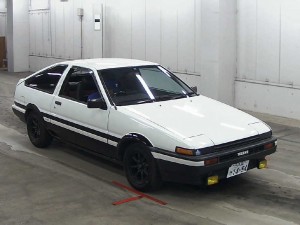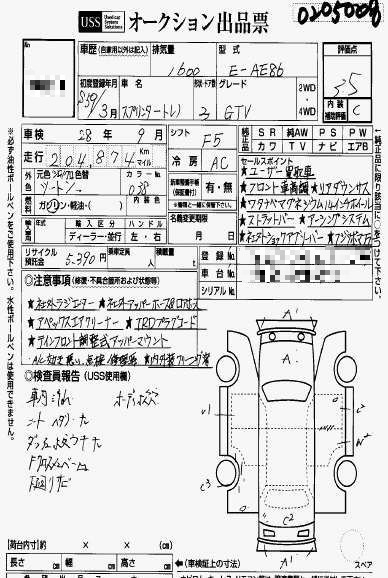Japanese Car Auction Find: Toyota AE86 — The Drifter's Dream
The Toyota Corolla today is one of the most popular cars in existence, due to its small but durable size and budget-friendly pricing. However, few people know much about its history or what kinds of models went into making the final product. One of these earlier types was the Toyota AE86, which was introduced by Toyota in 1983 as part of the fifth generation Toyota Corolla, with the final models rolling off the production lines in 1987. As such, it is just one generation of the Toyota Corolla Levin and Toyota Sprinter Trueno spanning the years from 1972 to 2004.
There were some differences between the Levin and the Trueno, but to the general observer they were almost indistinguishable. The word “Levin” means “lightning” in Old English and “Trueno” means “thunder” in Spanish, making the two models an interesting play on words. Other than the names, the main difference between them was the headlights: while the Levin had fixed, rectangular headlights, the Trueno offered pop-up headlights instead.
One of the unique aspects of the AE86 was that it maintained a rear-wheel drive at a time when most other cars – particularly small hatchbacks – were switching over to front-wheel drive. As such, it is one of the last rear-wheel drive cars of its time. The AE86 body type was offered as either a 2-door coupe or 3-door liftback, which can also be called a hatchback. Other specifications included the 4-cylinder engine that was also used in other Toyota models of the time, as well as a 5-speed manual gearbox (although an automatic model was offered later as well).
Stopping and cornering on the AE86 was handled by ventilated disc brakes, as well as a MacPherson strut independent suspension at the front and a four-link live axle with coil springs bringing up the rear. Stabilizer bars were present at both ends of the car to make for a suspension system that was relatively sophisticated for what was a low-end model. All of this attention to detail lead to the fun handling that makes the car a stand-out model today in the minds of Japanese classic car enthusiasts.
During its production lifetime, the AE86 was well known for its achievements on the racetrack as well as the highway. The model was a popular choice for showroom stock, Group A, and Group N racing, and was found especially frequently in rallying and circuit races. Privateer teams continued to race the AE86 even after it was discontinued, and you can even find teams that race with this vehicle today. What makes it so appealing is its rear-drive configuration, which is not found in many other cars of the era and especially not in modern models of lightweight coupes.
The car was popular in races in Ireland and Finland, and also did well in international touring races where it competed mainly with Honda Civics and others lightweight vehicles of its type. In 1986, it was entered in the European Touring Car Championship and won the Manufacturers Championship, beating out larger cars including the BMW M6, BMW 325i (E30), Rover Vitesse, Volvo 240 Turbo, Merkur XR4Ti, Mazda 929, Holden Commodore (VK), Alfa Romeo 75 (turbo V6), and Mercedes 190E.
Japanese street racers, known as hashiriya, prized the AE86 as well for its light weight, relative strength and especially its rear-wheel driving configuration, which made it popular for races through mountain passes where downhill corners were particularly suited to the capabilities of this car. In particular, the AE86 was well adapted to drifting, or the process of controlled sliding through corners. Japanese drifters like Katsuhiro Ueo, Toshiki Yoshioka, Yoichi Imamura, Koichi Yamashita, Hiroshi Takahashi, Tetsuya Hibino, and Wataru Hayashi made the AE86 famous in the drift scene in the 1980s.
As a result of its popularity in Japan, the AE86 was found in many episodes of Japanese anime and manga; the model also made a brief appearance in Fast and Furious 4 and The Fast and the Furious: Tokyo Drift, indicating its popularity in American popular culture as well. It is also featured in a number of video game series, including Gran Turismo, Tokyo Xtreme Racer, Grand Theft Auto IV and Grand Theft Auto V. It also appears in several video games and movies in the Need for Speed franchise, including Need for Speed: Underground 2, Need for Speed: The Run (where it can be used in challenges and multiplayer events), Need for Speed: World, Need for Speed: Pro Street, and Need for Speed (2015 movie).
Here is a 1984 Sprinter Trueno GTV that is in the car auctions in Japan. The mileage is high, but that is typical for cars of this age. This car has a lot of aftermarket parts, and seems to be in relatively good condition considering its age:
“Grade 3.5, first registered March 1984, 204,874KM, GTV model, five-speed manual gearbox, AC, front adjustable suspension, rear lowered suspension, Watanabe magnesium 14 inch wheels, strut bar, earthing system, aftermarket shock absorbers, super muffler, aftermarket radiator, aftermarket upper hose and lower hose, Apex air cleaner, TRD plug courts, Tein front adjustable-type upper mount, AC does not work well and needs repair, interior grime, ???? (unreadable) hole in body work, seats sagging and cut, dashboard loose and cut, front cross member dented, rust underneath vehicle, corrosion and other marks as per map”






